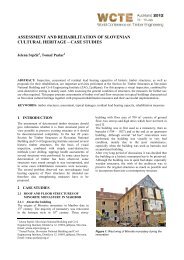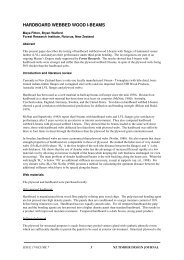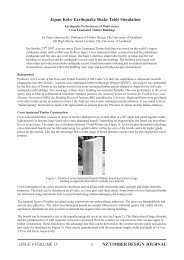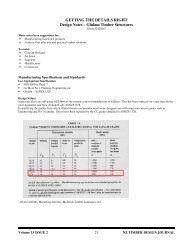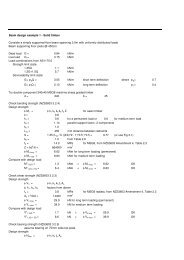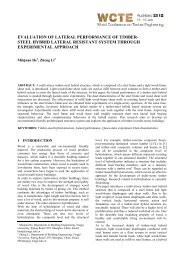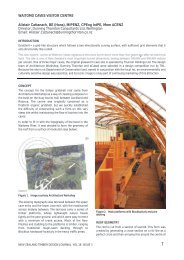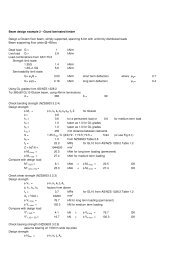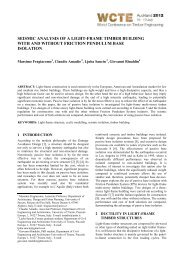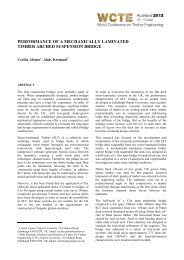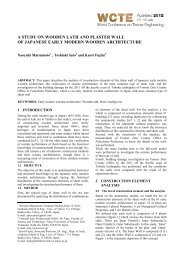00547 Maik Gehloff - Timber Design Society
00547 Maik Gehloff - Timber Design Society
00547 Maik Gehloff - Timber Design Society
You also want an ePaper? Increase the reach of your titles
YUMPU automatically turns print PDFs into web optimized ePapers that Google loves.
PERFORMANCE OF MOMENT RESISTING SELF-TAPPING<br />
SCREW ASSEMBLY UNDER REVERSE CYCLIC LOAD<br />
Maximilian Closen 1 , Frank Lam 2<br />
ABSTRACT: This paper evaluates the performance of a moment resisting self-tapping screw assembly with tension<br />
and compression plates as connecting members in a typical beam to column connection subjected to reverse cyclic<br />
loads. Throughout the test series two main connection failure modes were observed. Failure mode one shows significant<br />
wood crushing in combination with transverse shear failure in the column member with a generally slow load decrease<br />
and continuous rotation of the beam member. Failure mode two shows sudden failure caused by tension fracture of the<br />
self-tapping wood screws in the beam member. The results show that this connection exceeds the bending moment<br />
design capacity of the glulam material by a factor of 2 in positive direction and a factor of 1.9 in the negative direction.<br />
In general strong performance with very little capacity and stiffness degradation was observed.<br />
KEYWORDS: Stress/failure analysis, timber structures, full thread self-tapping screws<br />
1 INTRODUCTION 123<br />
<strong>Timber</strong> connections with stocky dowels or bolts are<br />
critical structural members that are generally prone to<br />
brittle failure. Brittle failure occurs due to the poor<br />
tensile perpendicular to grain and longitudinal shear<br />
strengths of wood. When not intended in the design these<br />
connections can fail prematurely when subjected to<br />
stresses other than shear. During seismic events<br />
connections are likely to experience additional stresses<br />
caused by bending moments that were not considered<br />
during the design. Furthermore [1], reports the issue of<br />
restrained shrinkage in connections with slotted-in steel<br />
plates that use dowels or bolts as connecting members as<br />
critical with a potential for wood splitting and significant<br />
connection capacity reductions.<br />
Past research [2], [3], [4] proposes reinforcements that<br />
effectively reduce the tendency of wood splitting<br />
perpendicular to the grain by using structural full thread<br />
self-tapping wood screws (STS). [5] reports outstanding<br />
performances of bolted timber moment connections with<br />
STS reinforcement’s perpendicular to the wood grain.<br />
The reinforcing effect of STS in wood is based on<br />
principals that are similar to rebar’s in concrete. The<br />
special thread shape with assymetrical-symetrical thread<br />
1 Maximilian Closen, Department of Wood Science, University<br />
of British Columbia, 2842 - 2424 Main Mall, Vancouver, BC,<br />
V6T 1Z4, Canada. Email: mclosen@interchange.ubc.ca<br />
2 Frank Lam, Department of Wood Science, University of<br />
British Columbia, 2424 Main Mall, Vancouver, BC, V6T 1Z4,<br />
Canada. Email: frank.lam@ubc.ca<br />
pitches firmly bounds to the wood fibre over multiple<br />
layers (Figure 1). The bite of the thread forms a stiff<br />
connection to the wood. As stiff structural elements<br />
typically attract loads; therefore, it can be assumed that<br />
the majority of occurring stresses perpendicular to the<br />
grain is transferred as a tensile stress along the screw<br />
axis. Since STS are hardened after rolling on the thread a<br />
high tensile strength is achieved. The combination of<br />
high tensile strength and threads that firmly bite into the<br />
wood fibre are an effective method of splitting<br />
reinforcement.<br />
Figure 1: Screw thread embedded in the wood<br />
Current research has intensely addressed the reinforcing<br />
potential and withdrawal capacities of STS in timber<br />
connections; however, the potential of these fasteners as<br />
primary connector has been neglected. Utilizing the<br />
previously described properties of these screws as<br />
primary fastener strong, reliable and cost efficient timber<br />
connections can be created. [6] reports the application of<br />
STS as primary fastener in rigid frame corners with
significant higher load bearing potential when compared<br />
to glued finger joints and dowels. The configuration of<br />
the STS for this joint type however requires modelling of<br />
internal stress flows using the principles of strut-and-tie<br />
systems. Because many engineers have limited access to<br />
appropriate high cost modelling software this promising<br />
approach may not be commonly applied in practice until<br />
design equations are derived.<br />
In this study an experimental investigation was<br />
conducted to evaluate the performance of a moment<br />
resisting STS assembly (see Figure 5). The capacity of<br />
the assembly primarily depends on the shear and<br />
withdrawal resistance of the STS which can according to<br />
[7], in most cases, conservatively be estimated in major<br />
Canadian species using the design equations presented in<br />
[8]. A total of ten specimens were subjected to reverse<br />
cyclic loading conditions. In the following the<br />
performance of the moment resisting STS assembly in<br />
terms of ultimate capacities, stiffness and ductility is<br />
presented. In addition, a detailed description of all<br />
observations made during testing is provided.<br />
compression plates (ZD-plates). To allow for<br />
construction tolerances, the housing was oversized by 2<br />
mm in depth and 4 mm in width. These tolerances<br />
proofed to be sufficient for the specimen assembly in the<br />
lab. Each ZD-plate received four 10 mm x 240 mm<br />
ASSY VG countersunk head screws driven-in at a<br />
±30°angle to the wood grain of the beam member (see<br />
Figure 4). Detailed information about strength<br />
parameters and characteristics of the ASSY VG screws<br />
such as minimum requirements on the raw wire material,<br />
yield moment and tensile strength are summarized in [9]<br />
with links to proposed design equations in [8] and [10].<br />
In [11] a proposed design approach which estimates the<br />
capacity of connections with ZD-plates can be found.<br />
2 MATERIALS AND METHOD<br />
All specimens for this test series were cut from the<br />
centre lamellas of 130 mm x 912 mm Canadian Douglas<br />
fir glulam of stress grade 20f-E. As a typical example for<br />
the investigated connection a beam to column or column<br />
base connection can be assumed. Both connection<br />
application examples are typically needed in timber<br />
moment frames or simply as a column base-fixture.<br />
A custom made steel shoe assembly (see Figure 2) using<br />
9.5 mm thick steel plates was welded to fit the 130 mm x<br />
304 mm vertical beam member. On each side of the<br />
shoe, steel brackets were welded to the vertical steel<br />
plates for additional stiffening. To connect the vertical<br />
steel plates a 200 mm x 304 mm bracing-steel plate was<br />
welded in between. To be able to fit the beam member<br />
into the steel shoe a 12 mm wide and 220 mm deep slot<br />
needed to be cut into the lower beam end. Bearing of the<br />
beam member on the bottom steel plate and the bracing<br />
steel plate during load application was avoided by<br />
providing a 20 mm gap by simply slotting the beam to a<br />
depth of 220 mm. A second 9.5 mm thick bottom steel<br />
plate was fastened to the horizontal column member<br />
using 10 mm x 240 mm ASSY VG screws. A total of<br />
twelve 12.5 mm Grade 5 bolts were used to connect the<br />
steel shoe to the bottom steel plate through 13 pre-drilled<br />
holes with 12.5 mm receiver nuts welded on the bottom.<br />
Each bolt and nut was equipped with a 35 mm washer<br />
and tightened to a pre-set torque of 200 Nm. All timber<br />
members were fabricated using the Hundegger K2 5-axis<br />
fully automated joinery machine that was available at the<br />
Centre of Advanced Wood processing at the University<br />
of British Columbia (UBC). The previously mentioned<br />
12 mm x 220 mm slot in the beam member was cut using<br />
the Hundegger K2 circular saw. The required 40 mm x<br />
25 mm round housing for the receiver nut and washer at<br />
the column member was milled using a 25 mm finger<br />
mill. The 25 mm mill was also used to mill the column<br />
member housing for the 27 mm x 86 mm tension and<br />
Figure 2: Custom steel shoe and bottom steel plate<br />
(some parts were removed from drawing for clarity)<br />
(all measures in mm)<br />
Moisture content measurements with a resistance<br />
moisture meter at all specimen ranged between10.3 %<br />
and 11.8 % prior to assembly.<br />
To reduce the impact of wood crushing on data<br />
recordings at the location of the horizontal tie downs five<br />
10 mm x 240 mm ASSY VG screws were driven-in<br />
perpendicular to the grain (see Figure 3). The tie down<br />
steel pipe was now bearing on the screw head preventing
the wood from crushing under large loads. Because large<br />
loads and heavy deformations were expected on the steel<br />
shoe they were replaced after each test.<br />
cycle was selected with a deformation of 0.05∆ followed<br />
by a primary cycle of 0.075∆. This sequence progresses<br />
up to 2.0∆.<br />
Figure 3: Typical bearing reinforcement<br />
Figure 5: Test set-up<br />
The horizontal force component applied at the top of the<br />
beam member was recalculated using the displacement<br />
recording of a linear position transducer mounted<br />
vertically under the actuator (see Figure 6). Furthermore<br />
two cable extension position transducers were attached<br />
to the beam member in two different heights. These<br />
recordings were used to calculate the horizontal<br />
movement of the member from which moment rotation<br />
plots can be derived. A multi-purpose test system<br />
controlled the single ended MTS actuator with 250 mm<br />
stroke in positive and negative direction during load<br />
application.<br />
Figure 4: ZD-plate specifications from SWG-Production<br />
(all measures in mm)<br />
The entire research project was conducted at the UBC<br />
<strong>Timber</strong> Engineering and Applied Mechanics (TEAM)<br />
test facility. An illustration of the general test setup is<br />
shown in Figure 5. Ten specimens were subjected to<br />
displacement controlled reverse cyclic loading according<br />
the test procedure developed by [12]. This protocol<br />
consists of initiation cycles, trailing cycles and primary<br />
cycles with equal positive and negative amplitudes. The<br />
initiation cycles at the beginning serve to check the test<br />
equipment and the load deformation response. Primary<br />
cycles mark the beginning of a new displacement phase<br />
and are followed by trailing cycles with 75% of the<br />
amplitude of the respective primary cycle of each phase.<br />
The loading sequence was calibrated to the average<br />
reference deformation ∆ ultimate = 3° which was obtained<br />
from two monotonic tests with a constant loading rate of<br />
16 mm per minute. To account for variations between<br />
monotonic and cyclic testing and damage accumulation<br />
the suggested deformation ∆ =0.6∆ ultimate was applied to<br />
determine the final loading procedure. The first initiation<br />
3 RESULTS AND DISCUSSION<br />
The recorded loads, displacements and geometric data<br />
were used to derive moment rotation plots. A straight<br />
line segment connecting the point of 0.4M max with the<br />
origin of the moment rotation curve was used to define<br />
the initial connection stiffness. Where applicable, a yield<br />
moment derived from the point of intersection of the<br />
initial stiffness line and a tangent to the moment rotation<br />
curve having 1/6 of the slope of the initial stiffness line<br />
was calculated. In specimen with a steep load drop after<br />
the maximum moment was reached no yield moment<br />
was derived.<br />
The moment resistance of the assembly was calculated at<br />
the centre of rotation of the steel shoe.
Figure 6: General test layout and testing equipment (all measures in mm)<br />
Therefore, the horizontal force component was<br />
multiplied with the respective corrected distance (C in<br />
Figure 6) to the centre of rotation. Respective rotations<br />
of the beam member were derived from the geometric<br />
measurements of points B, D and E in Figure 6. The STS<br />
assembly with tension and compression plates shows<br />
high moment capacities with small rotations throughout<br />
the entire test series. Because of the layout of the steel<br />
shoe with a large number of bolts and bracings a tension<br />
fracture failure of the screws was promoted. Mostly this<br />
tension fracture resulted in brittle connection failures at<br />
small rotations of the beam member. Due to the high<br />
horizontal forces that the connection resisted during<br />
testing, compression failures in the beam member at the<br />
point of load application were observed. As a result up<br />
and down shifting of the load application fixture started<br />
to occur in progressed cycles (Figure 7). Compression<br />
failures of the wood were also observed on the column<br />
member at the location of the tie down steel pipes. At<br />
this location 16 mm steel plates and 10 mm x 240 mm<br />
full thread screws were applied to resist the expected<br />
high compression stresses. Three specimens did however<br />
fail regardless of the reinforcement and enlarged bearing<br />
area in a failure combination of compression<br />
perpendicular to grain and transverse shear (Figure 7).<br />
Furthermore, the intense crushing and splitting of the<br />
column member caused gaps to develop between the<br />
concrete strong floor and the bottom of the column. At<br />
maximum load these gaps measured approximately 15<br />
mm to 20 mm in positive and negative direction. Finally<br />
this resulted in higher rotations of respective specimens<br />
(see Figure 8). The intended 20 mm gap between the<br />
bottom of the beam member and the steel shoe proved to<br />
be sufficient throughout the test series. No bearing of the<br />
beam member on the steel shoe in either positive or<br />
negative direction with potential for increasing the<br />
moment resistance was observed.<br />
Figure 7: Typical wood crushing at point of load<br />
application (beam member) and compression -<br />
transverse shear failure (column member)<br />
Figure 8: Developed gap due to intense wood crushing<br />
and transverse shear failure at bottom of column member
The M16 (10.9) bolts used to connect the steel shoe to<br />
the ZD-plates of the beam member showed signs of<br />
heavy local stresses on the thread shortly under the hexhead.<br />
Up and down movement of the bolts was observed<br />
throughout all tests in progressed cycles. Heavy bending<br />
of the short, stocky bolts was found in three tests after<br />
the specimen were disassembled (see Figure 9). In these<br />
tests withdrawal resistance and push out failure of the<br />
full thread screws on one side of the beam member<br />
occurred and a gap between the ZD-plate bottom and the<br />
wood was formed. This gap caused an increased bending<br />
stress on the screws forcing them to yield therefore<br />
reducing the connection stiffness and capacity. Typically<br />
the combination of high tensile stresses and screw<br />
bending causes brittle fractures in hardened fasteners.<br />
In [11] failure of the thread inside the ZD-plates and<br />
failure at the bolt thread is reported. In addition [11]<br />
reports bending of the ZD-plates under heavy loads. This<br />
observation cannot be confirmed. One may assume that<br />
the shorter ZD-plates (86 mm length) used for tests in<br />
this project compared to the 100 mm used in [11]<br />
provide higher stiffness’s and therefore larger bending<br />
strength.<br />
As it can be seen in Figure 10 the M16 bolts were<br />
pushed out (away from the steel plate surface) in a way<br />
that no bearing of the bolt head on the steel plate was<br />
prevented. The cab formed ranged between<br />
approximately 2 mm and 4 mm. In general the largest<br />
gap formed at the top bolt with decreasing gap size<br />
toward the bottom of the beam member. A possible<br />
reason for the loosening of the bolts may be the large<br />
number of cycles that the specimen was subjected to and<br />
the small vibrations that were caused by the friction<br />
between the steel plate and the wood.<br />
Table 1 and Table 2 summarize the results for the ten<br />
tests which were derived from the moment-rotation<br />
relationships and the geometric data recordings as<br />
outlined in previous chapters. In Figure 11 a typical<br />
moment-rotation plot from specimens with significant<br />
wood crushing and transverse shear failure in the column<br />
member (observed in three out of ten tests) is shown. As<br />
a result of wood crushing and transverse shear failure no<br />
sudden load drops as seen in Figure 12 in either cycle<br />
can be seen. A load drop of approximately 20% of the<br />
recorded maximum load occurred in the positive cycle.<br />
After specimen disassembly it was found that this load<br />
drop was caused by the fracture of one tension screw in<br />
the top ZD-plate. The remaining screws on this side of<br />
the specimen were still functioning to carry loads and<br />
showed only little signs of high stresses with regard to<br />
screw bending and screw withdrawal. In all tests the<br />
failure of the connection initiated in the top ZD-plate and<br />
then progressed downward toward the column member.<br />
Figure 11: Typical Moment rotation plot derived from<br />
specimen Mc-10 with significant wood crushing and<br />
transverse shear failure at the column member in the<br />
positive and negative cycle.<br />
Figure 9: Bolt bending<br />
Figure 12: Typical Moment rotation plot derived from<br />
specimen Mc-4 with wood crushing at the column<br />
member in the positive cycle and tension fracture failure<br />
of screws with a related steep load drop in negative<br />
cycle.<br />
Figure 10: Bolt push-out
Beside a fracture failure of the screws in tension a<br />
withdrawal-push-out failure of the compression screws<br />
was observed mostly in the top ZD-plates (see Figure<br />
13). A significant visible failure on the ZD-plate itself<br />
was not found however slight indentations at the lid<br />
caused by the head of the compression screw were found<br />
throughout the entire test series. In addition, significant<br />
bending of the compression screws indicating high shear<br />
stresses at the interface between the ZD-plate and the<br />
wood member occurred. In general little signs of high<br />
stresses were observed at the bottom ZD-plate<br />
Figure 13: Observed withdrawal-push out failure (top left) and disassembled ZD-plate with compression screw bending<br />
and fractured tension screws after testing (top right). Screw withdrawal in column member (bottom left).Tension fracture<br />
of 12.5 mm bolt and steel plate yielding (bottom right).<br />
Beside the failure modes of the tension and compression<br />
screws in the beam member withdrawal failure of the<br />
screws driven into the column member also occurred.<br />
Along with the withdrawal of the screws tension splitting<br />
perpendicular to the grain at the location of the screws<br />
tip was observed. It is assumed that large tensile stresses<br />
were transferred through the screw shaft resulting in high<br />
stress concentrations at the screw tip. These stress<br />
concentrations finally cause wood splitting perpendicular<br />
to the grain. A further failure observed at the steel shoe<br />
was tension fracture of the 12.5 mm bolts. Accordingly<br />
the bottom steel plate separated itself from the top steel<br />
plate through significant yielding and screw withdrawal<br />
(see Figure 13).
Table 1: Summary of recorded test results<br />
Mc-1 Mc-2 Mc-3 Mc-4 Mc-5<br />
pos. neg. pos. neg. pos. neg. pos. neg. pos. neg.<br />
cycle cycle cycle cycle cycle cycle cycle cycle cycle cycle<br />
max M. [KNm] 69.34 -101.8 88.81 -86.07 79.20 -82.90 89.14 -85.53 108.4 -80.87<br />
rotation @ max M. [°] 2.84 -8.46 3.25 -2.67 3.61 -4.21 2.59 -2.51 2.99 -3.24<br />
failure M. [KNm] 55.47 -81.46 71.05 -68.86 63.36 -66.32 71.32 -68.43 86.73 -64.70<br />
rotation @ failure [°] 3.30 -4.34 3.90 -2.82 3.82 -5.18 3.46 -3.28 3.00 -3.67<br />
40% max M. [KNm] 27.74 -40.73 35.52 -34.43 31.68 -33.16 35.66 -34.21 43.36 -32.35<br />
rotation @ max M. [°] 1.27 -2.16 1.41 -1.47 1.28 -1.44 0.92 -1.08 0.91 -0.98<br />
yield M. [KNm] - - - - - -79.62 83.90 - 101.5 -75.65<br />
rotation @ yield M. [°] - - - - - -3.46 2.25 - 2.13 -2.29<br />
stiffness. [KNm/°] 21.90 18.87 30.52 33.85 24.75 22.97 38.87 35.05 47.75 33.01<br />
ductility [-] - - - - - 1.17 1.15 - 1.40 1.41<br />
Mc-6 Mc-7 Mc-8 Mc-9 Mc-10<br />
pos. neg. pos. neg. pos. neg. pos. neg. pos. neg.<br />
cycle cycle cycle cycle cycle cycle cycle cycle cycle cycle<br />
max M. [KNm] 107.8 -88.31 99.55 -88.41 95.22 -100.9 93.26 -93.98 102.5 -89.18<br />
rotation @ max M. [°] 3.60 2.81 3.55 2.19 3.12 2.87 3.46 4.26 3.14 2.76<br />
failure M. [KNm] 86.28 -70.65 79.64 -70.73 76.17 -80.79 74.61 -75.19 82.02 -71.34<br />
rotation @ failure [°] 3.55 -3.27 4.24 -2.68 3.33 -3.13 3.65 -4.92 3.36 -3.32<br />
40% max M. [KNm] 43.14 -35.32 39.82 -35.36 38.09 -40.39 37.30 -37.59 41.01 -35.67<br />
rotation @ max M. [°] 1.44 -1.14 2.01 -0.90 1.27 -1.05 1.40 -2.08 1.13 -1.05<br />
yield M. [KNm] 106.2 -81.31 - - 94.83 -99.52 - - 95.43 -86.82<br />
rotation @ yield M. [°] 3.05 -2.35 - - 3.12 -2.58 - - 2.71 -2.55<br />
stiffness. [KNm/°] 34.93 37.50 27.27 47.15 29.89 38.47 31.18 23.79 36.36 33.97<br />
ductility [-] 1.18 1.19 - - 1.00 1.11 - - 1.16 1.08<br />
Table 2: Summary statistics of tests results<br />
pos. cycle<br />
neg. cycle<br />
Average Stdev. COV Average Stdev. COV<br />
max M. [KNm] 93.33 12.38 0.13 -89.81 7.08 -0.08<br />
rotation @ max M. [°] 2.92 1.02 0.35 -0.62 4.17 -6.72<br />
failure M. [KNm] 74.66 9.90 0.13 -71.84 5.66 -0.08<br />
rotation @ failure M. [°] 3.56 0.36 0.10 -3.66 0.86 -0.24<br />
40% max M. [KNm] 37.33 4.95 0.13 -35.92 2.83 -0.08<br />
rotation @ max M. [°] 1.30 0.31 0.24 -1.33 0.45 -0.34<br />
yield M. [KNm] 96.62 9.68 0.10 -84.58 9.26 -0.11<br />
rotation @ yield M. [°] 2.64 0.52 0.20 -2.65 0.47 -0.18<br />
stiffness. [KNm/°] 32.34 7.50 0.23 32.46 8.42 0.26<br />
When looking at the average ultimate capacity values<br />
listed in Table 2 for the positive and negative cycle one<br />
can see the high performance of this assembly. The<br />
average ultimate moment resistances exceeded the<br />
design moment capacity of the 130 mm x 304 20f-E<br />
grade glulam member by a factor of 2 in the positive and<br />
a factor of 1.9 in the negative cycle. Considering the<br />
high stiffness of the connection with 32.34 KNm/° in the<br />
positive and 32.46 KNm/° in the negative cycle<br />
application of this connection in real structures seems
appropriate. As a result of eventual fracture of the STS<br />
the ductility of this connection was relatively low. This<br />
can be easily amended with changing the details of the<br />
steel hardware to force the failure into a more ductile<br />
mode by ensuring steel yielding can occur before screw<br />
fracture and withdrawal.<br />
4 CONCLUSIONS<br />
The research projected presented in this paper evaluated<br />
the performance of a moment resisting self-tapping<br />
screw assembly under reverse cyclic load. The applied<br />
tension and compression plates in combination with selftapping<br />
wood screws arranged at 30° to the wood grain<br />
of the beam member resulted in high moment resistance<br />
and very high connection stiffness. Failure of the main<br />
connecting members, the 10 mm x 240 mm ASSY VG<br />
screws, was promoted through the thick bottom steel<br />
plate and the large number of 12.5 mm bolts that were<br />
used as connector at the bottom. The ultimate moment<br />
resistance exceeded the bending moment design capacity<br />
by a factor of 2 in the positive direction and a factor of<br />
1.9 in the negative direction. Main failure modes<br />
observed in the beam member were tension fracture and<br />
withdrawal of screws. In the column member wood<br />
splitting perpendicular to the grain and compression/<br />
transverse shear failure occurred. At the steel shoe<br />
bottom plate significant yielding and tensile failure of<br />
bolts were observed in progressed cycles under heavy<br />
loads.<br />
Even though the ductility of this connection was<br />
relatively low, the high capacity of the tension and<br />
compression plates in combination with the STS allows<br />
one to weakening sections of the steel shoe and therefore<br />
promoting steel yielding instead of screw fracture.<br />
Forcing the steel parts to yield will eliminate brittle<br />
failure modes and increase ductility. In addition, the ease<br />
of assembly and the potential for pre-manufacturing<br />
instead of on site construction may broaden the field of<br />
application for STS connections in large structures.<br />
Creating timber connections that are capable of<br />
exceeding the capacity of the members they connect may<br />
significantly simplify the design of moment resisting<br />
self-taping screw assemblies in the future. This will<br />
form part of the on-going research and development<br />
activities at UBC on moment resisting connections.<br />
ACKNOWLEDGEMENT<br />
The cooperation received from Schraubenwerk Gaisbach<br />
Produktion (SWG) GmbH (www.swg-produktion.de) for<br />
the supply of the tension and compression plates (ZDplates)<br />
and the ASSY VG screws is appreciated.<br />
[2] Blass H.J.: Schmid M.: Self-tapping screws as<br />
reinforcement perpendicular to the grain in timber<br />
connections. Lehrstuhl fuer Ingenieurholzbau und<br />
Baukonstruktionen, University of Karlsruhe (TH)<br />
Germany, date unknown.<br />
[3] Bejtka I.: Verstaerkungen von Bauteilen aus Holz<br />
mit Vollgewindeschrauben. Lehrstuhl fuer<br />
Ingenieurholzbau und Baukonstruktionen,<br />
University of Karlsruhe Germany, 2005.<br />
[4] F. Lam., M. <strong>Gehloff</strong>., M. Closen.: Moment-resisting<br />
bolted timber connections. Proceedings of the<br />
Institution of Civil Engineers, Structures and<br />
buildings 163, pages 267-274, 2010.<br />
[5] M. <strong>Gehloff</strong>., M. Closen., F. Lam. Reduced edge<br />
distances in bolted timber moment connections with<br />
perpendicular to grain reinforcements. In 11 th World<br />
Conference on <strong>Timber</strong> Engineering, 2010.<br />
[6] M. Trautz, C. KOJ. Proceedings of the International<br />
Association for Shell and Spatial Structures (IASS)<br />
Symposium: Valencia, 2009. The RWTH Aachen<br />
University.<br />
[7] <strong>Gehloff</strong> M.: Pull-out Resistance of Self-Tapping<br />
Wood Screws with Continuous Thread. Department<br />
of Wood Science, The University of British<br />
Columbia Vancouver, Canada, 2011.<br />
[8] DIN (Deutsches Institut fuer Normung e.V.) DIN<br />
1052:2004-08: Entwurf, Berechnung und<br />
Bemessung von Holzbauwerken- Allgemeine<br />
Bemessungsregeln und Bemessungsregeln fuer den<br />
Hochbau. Beuth Verlag, Berlin, 2004.<br />
[9] DIBt Allgemeine Bauaufsichtliche Zulassung,<br />
Wuerth ASSY VG plus Vollgewindeschrauben als<br />
Holzverbindungsmittel. From Deutsches Institut<br />
fuer Bautechnik Berlin, Germany, 2006.<br />
[10] EC 5, EN 1995-1-1: (D), Eurocode 5: Bemessung<br />
und Konstrucktion von Holzbauten – Teil 1-1:<br />
Allgemeines- Allgemeine Regeln und Regeln fuer<br />
den Hochbau CEN/TC 250 Structural Eurocodes,<br />
1994.<br />
[11] Pruefbericht Nr. 106109: Versuche zur Ermittlung<br />
des Trag- und Verformungsverhaltens von<br />
biegesteifen Rahmenecken mit ZD-platten.<br />
Karlsruher Institut fuer Technology, Versuchsanstalt<br />
fuer Stahl, Holz und Steine Karlsruhe, Germany ,<br />
2010.<br />
[12] H. Krawinkler, F. Ibarra, L. A. Ayoub, R. Medina.<br />
Development of a testing protocol for wood frame<br />
structures. Rep. W-02, CUREE-Caltech Woodframe<br />
Project, Stanford University Stanford, California<br />
2001.<br />
REFERENCES<br />
[1] Sjoedin J.: Steel-to-<strong>Timber</strong> Dowel Joints- Influence<br />
of Moisture Induced Stresses. School of Technology<br />
and <strong>Design</strong>, Vaejoe University Sweden, 2006.



